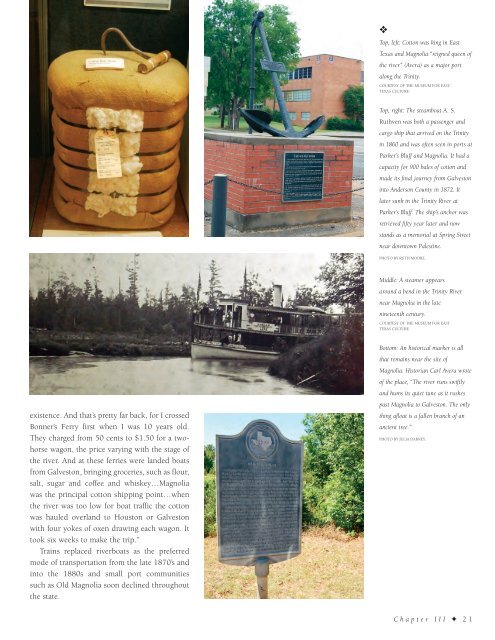Historic Palestine
An illustrated history of the Palestine, Texas area, paired with the histories of companies, families and organizations that make the region great.
An illustrated history of the Palestine, Texas area, paired with the histories of companies, families and organizations that make the region great.
You also want an ePaper? Increase the reach of your titles
YUMPU automatically turns print PDFs into web optimized ePapers that Google loves.
❖<br />
Top, left: Cotton was king in East<br />
Texas and Magnolia “reigned queen of<br />
the river” (Avera) as a major port<br />
along the Trinity.<br />
COURTESY OF THE MUSEUM FOR EAST<br />
TEXAS CULTURE.<br />
Top, right: The steamboat A. S.<br />
Ruthven was both a passenger and<br />
cargo ship that arrived on the Trinity<br />
in 1860 and was often seen in ports at<br />
Parker’s Bluff and Magnolia. It had a<br />
capacity for 900 bales of cotton and<br />
made its final journey from Galveston<br />
into Anderson County in 1872. It<br />
later sunk in the Trinity River at<br />
Parker’s Bluff. The ship’s anchor was<br />
retrieved fifty year later and now<br />
stands as a memorial at Spring Street<br />
near downtown <strong>Palestine</strong>.<br />
PHOTO BY RUTH MOORE.<br />
Middle: A steamer appears<br />
around a bend in the Trinity River<br />
near Magnolia in the late<br />
nineteenth century.<br />
COURTESY OF THE MUSEUM FOR EAST<br />
TEXAS CULTURE.<br />
existence. And that’s pretty far back, for I crossed<br />
Bonner’s Ferry first when I was 10 years old.<br />
They charged from 50 cents to $1.50 for a twohorse<br />
wagon, the price varying with the stage of<br />
the river. And at these ferries were landed boats<br />
from Galveston, bringing groceries, such as flour,<br />
salt, sugar and coffee and whiskey…Magnolia<br />
was the principal cotton shipping point…when<br />
the river was too low for boat traffic the cotton<br />
was hauled overland to Houston or Galveston<br />
with four yokes of oxen drawing each wagon. It<br />
took six weeks to make the trip.”<br />
Trains replaced riverboats as the preferred<br />
mode of transportation from the late 1870’s and<br />
into the 1880s and small port communities<br />
such as Old Magnolia soon declined throughout<br />
the state.<br />
Bottom: An historical marker is all<br />
that remains near the site of<br />
Magnolia. Historian Carl Avera wrote<br />
of the place, “The river runs swiftly<br />
and hums its quiet tune as it rushes<br />
past Magnolia to Galveston. The only<br />
thing afloat is a fallen branch of an<br />
ancient tree.”<br />
PHOTO BY JULIA DABNEY.<br />
C h a p t e r I I I ✦ 2 1
















